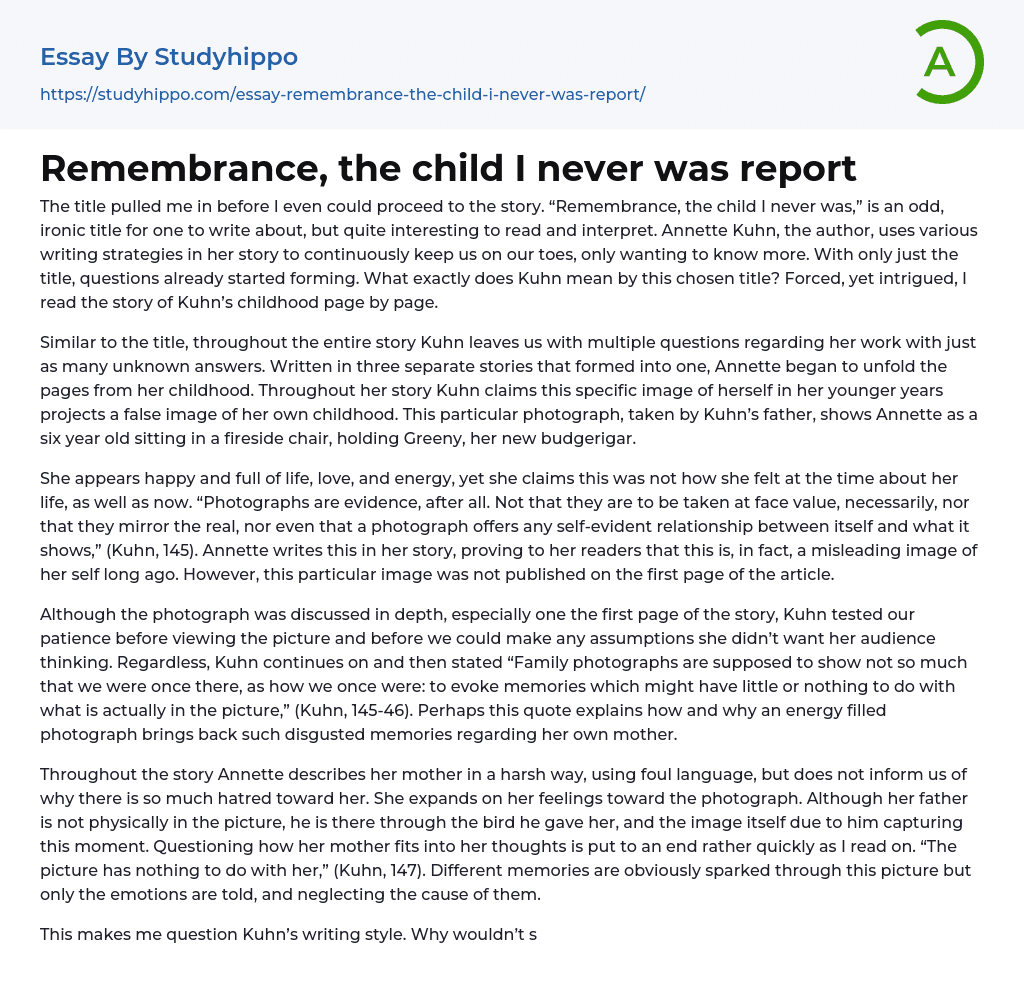The title pulled me in before I even could proceed to the story. “Remembrance, the child I never was,” is an odd, ironic title for one to write about, but quite interesting to read and interpret. Annette Kuhn, the author, uses various writing strategies in her story to continuously keep us on our toes, only wanting to know more. With only just the title, questions already started forming. What exactly does Kuhn mean by this chosen title? Forced, yet intrigued, I read the story of Kuhn’s childhood page by page.
Similar to the title, throughout the entire story Kuhn leaves us with multiple questions regarding her work with just as many unknown answers. Written in three separate stories that formed into one, Annette began to unfold the pages from her childhood. T
...hroughout her story Kuhn claims this specific image of herself in her younger years projects a false image of her own childhood. This particular photograph, taken by Kuhn’s father, shows Annette as a six year old sitting in a fireside chair, holding Greeny, her new budgerigar.
She appears happy and full of life, love, and energy, yet she claims this was not how she felt at the time about her life, as well as now. “Photographs are evidence, after all. Not that they are to be taken at face value, necessarily, nor that they mirror the real, nor even that a photograph offers any self-evident relationship between itself and what it shows,” (Kuhn, 145). Annette writes this in her story, proving to her readers that this is, in fact, a misleading image of her self long ago. However, this particular
image was not published on the first page of the article.
Although the photograph was discussed in depth, especially one the first page of the story, Kuhn tested our patience before viewing the picture and before we could make any assumptions she didn’t want her audience thinking. Regardless, Kuhn continues on and then stated “Family photographs are supposed to show not so much that we were once there, as how we once were: to evoke memories which might have little or nothing to do with what is actually in the picture,” (Kuhn, 145-46). Perhaps this quote explains how and why an energy filled photograph brings back such disgusted memories regarding her own mother.
Throughout the story Annette describes her mother in a harsh way, using foul language, but does not inform us of why there is so much hatred toward her. She expands on her feelings toward the photograph. Although her father is not physically in the picture, he is there through the bird he gave her, and the image itself due to him capturing this moment. Questioning how her mother fits into her thoughts is put to an end rather quickly as I read on. “The picture has nothing to do with her,” (Kuhn, 147). Different memories are obviously sparked through this picture but only the emotions are told, and neglecting the cause of them.
This makes me question Kuhn’s writing style. Why wouldn’t she want her readers to know what her mother did? Although it will forever be unknown to us all, I believe Annette wanted to keep her readers on her side of the story and not give her
mother any sympathy due to some readers relating to Annette’s same situation. “Remembrance” is told through multiple point of views. “My stories are made in a tension between past and present,” (Kuhn, 150). Annette said this because she jumps back and forth throughout the entire story.
One section was told through the point of view of Annette, the six year old, but the next page was told from Annette, today. I believe she does this as a writer so therefore we can relate to the context easier, and connect to the feelings she had about her childhood, then and now. Annette chose this picture to prove that she was not really the child it appears she was. Why this specific picture though? With her father as a photographer who she adored very much, there had to be more than one available image.
Is this the only photograph that truly depicts her false childhood? Also, during the course of Kuhn’s story, Annette mentions how her father captured this photograph of her but then indicates he isn’t actually her father according to her mother. This leads me to wondering if Annette Kuhn chose this photograph because of what it showed within the frame or because of who took it? Even with all of these unknown answers to the questions several contain, the most important is still out there. Is Annette Kuhn telling the truth? Ironically Annette includes within her story, “Make what you will of these bits of information, true or not. What you make of them will be guided by certain knowledges”.
- Child essays
- Child labor essays
- Childcare essays
- Ambition essays
- Anger essays
- Betrayal essays
- Boredom essays
- Confidence essays
- Courage essays
- Desire essays
- Disgrace essays
- Doubt essays
- Empathy essays
- Fairness essays
- Fear essays
- Feeling essays
- Forgiveness essays
- Grief essays
- Guilt essays
- Happiness essays
- Harmony essays
- Hate essays
- Honesty essays
- Honor essays
- Hope essays
- Humanity essays
- Inspiration essays
- Kindness essays
- Laughter essays
- Loneliness essays
- Lost essays
- Loyalty essays
- Need essays
- Passion essays
- Pressure essays
- Pride essays
- Regret essays
- Respect essays
- Responsibility essays
- Sarcasm essays
- Shame essays
- Suffering essays
- Suspense essays
- Tolerance essays
- Accident essays
- Awareness essays
- Benefits of Volunteering essays
- Challenges essays
- Childhood Memories essays
- Decision essays




